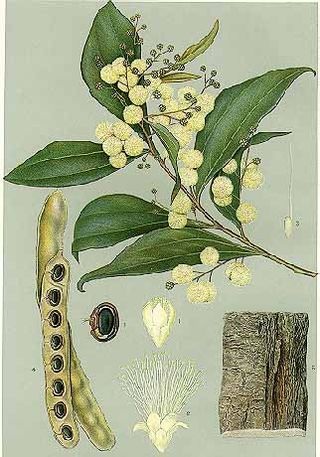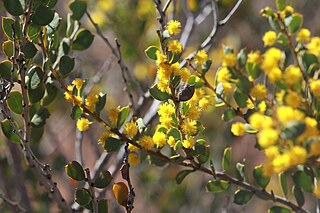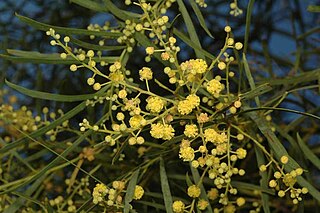
Acacia binervata, commonly known as two-veined hickory, is a shrub or tree that is endemic to eastern Australia.

Acacia argyrodendron, known colloquially as black gidyea or blackwood, is a species of flowering plant in the family Fabaceae and is endemic to Queensland. It is a tree with hard, furrowed bark, narrowly linear to elliptic phyllodes, golden yellow flowers arranged in racemes, and linear pods up to 120 mm (4.7 in) long.

Acacia atkinsiana, commonly known as Atkin's wattle, is a species of flowering plant in the family Fabaceae, and is endemic to the north of Western Australia. The indigenous peoples of the area where the shrub is found, the Kurrama peoples, know the shrub as bilari or pilarri. It is an open, spreading, usually V-shaped shrub with very narrowly elliptic phyllodes and heads of oblong or spherical racemes of 70 to 90 densely-arranged flowers and linear pods up to 100 mm (3.9 in) long.

Acacia acoma is a species of flowering plant in the family Fabaceae and is endemic to inland ares of south-western Western Australia. It is an erect, spindly, open or spreading shrub with variably-shaped, often narrowly oblong phyllodes, flowers arranged in spherical heads, usually arranged in pairs in leaf axils, and strongly curved or spirally coiled pods up to 15 mm (0.59 in) long when expanded.

Acacia aestivalis is a species of flowering plant in the family Fabaceae and is endemic to the south-west of Western Australia. It is a bushy shrub or tree with linear to narrowly lance-shaped phyllodes, the narrower end towards the base, racemes of 5 to 11 spherical heads of golden-yellow flowers, and glabrous, papery to thinly leathery pods.

Acacia anceps, commonly known as Port Lincoln wattle or the two edged wattle, is a species of flowering plant in the family Fabaceae and is endemic to coastal areas of south-western Australia. It is a bushy, spreading shrub with glabrous branchlets angled at the ends, elliptic to lance-shaped phyllodes with the narrower end towards the base, spherical heads of 50 to 130 golden-yellow flowers, and narrowly oblong pods up to 60 mm (2.4 in) long.

Acacia andrewsii is a species of flowering plant in the family Fabaceae and is endemic to the south-west of Western Australia. It is an intricately-branched shrub with narrowly oblong to lance-shaped, sometimes linear phyllodes, spherical heads of 20 to 30 golden-yellow flowers, and leathery pods up to 65 mm (2.6 in) long.

Acacia anthochaera, commonly known as Kimberly's wattle, is a species of flowering plant in the family Fabaceae and is endemic to Western Australia. It is a rounded shrub or tree with narrowly linear phyllodes, racemes of 4 to 9 spherical heads of bright light golden flowers, and narrowly oblong, papery pods up to 85 mm (3.3 in) long.

Acacia aphanoclada, also known as Nullagine ghost wattle, is a species of flowering plant in the family Fabaceae and is endemic to a small area in the Pilbara region of Western Australia. It is a glabrous wispy shrub with narrowly linear phyllodes, racemes of spherical heads of golden flowers, and narrowly oblong, papery pods up to 60–70 mm (2.4–2.8 in) long.

Acacia validinervia also commonly known as nyalanyalara, nyala nyala, alumaru or blue wattle, is a shrub of the genus Acacia and the subgenus Phyllodineae endemic to arid areas of inland Australia.

Acacia ascendens is a species of flowering plant in the family Fabaceae and is endemic to inland areas of Western Australia. It is an erect shrub with inclined to erect phyllodes that are round in cross-section, spherical heads of golden yellow flowers, and narrowly oblong pods up to 70 mm (2.8 in) long.

Acacia multisiliqua is a shrub or tree of the genus Acacia and the subgenus Plurinerves that is endemic to northern Australia.

Acacia trulliformis is a shrub of the genus Acacia and the subgenus Plurinerves that is endemic to an area of south western Australia.

Acacia alcockii, also known as Alcock's wattle, is a species of flowering plant in the family Fabaceae and is endemic to South Australia. It is a bushy shrub with narrowly elliptic to lance-shaped phyllodes with the narrower end towards the base, and racemes of 5 to 11 spherical heads of pale yellow flowers, and oblong pods.

Acacia alleniana is a species of flowering plant in the family Fabaceae and is endemic to northern parts of Australia. It is a spindly, open shrub or tree with slender branchlets, thread-like phyllodes, and yellow flowers arranged in 2 to 6 spherical heads in the axils of phyllodes, and thinly leathery pods up to 150 mm (5.9 in) long.

Acacia attenuata is a species of flowering plant in the family Fabaceae and is endemic to south-east Queensland. It is a slender shrub with lance-shaped or narrowly oblong phyllodes, often also juvenile bipinnate leaves, cream-coloured flowers arranged in head of 20 to 35, and papery or leathery pods up to 100 mm (3.9 in) long.

Acacia barringtonensis, commonly known as Barrington wattle, is a shrub belonging to the genus Acacia and the subgenus Phyllodineae endemic to New South Wales.

Acacia falciformis, also commonly known as broad-leaved hickory, hickory wattle, mountain hickory, large-leaf wattle, tanning wattle and black wattle, is a shrub belonging to the genus Acacia and the subgenus Phyllodineae that is endemic to eastern Australia

Acacia ruppii, commonly known as Rupp's wattle, is a shrub belonging to the genus Acacia and the subgenus Phyllodineae native to eastern Australia. It is listed as endangered in the Environment Protection and Biodiversity Conservation Act 1999.

Acacia torringtonensis is a species of flowering plant in the family Fabaceae and is endemic to a small area in northern New South Wales in Australia. It is an erect or spreading shrub with crowded, linear to narrowly elliptic phyllodes and spherical head of yellow to bright yellow flowers.






















